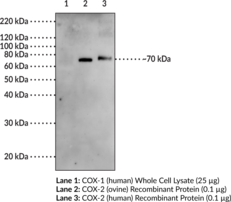Description
Cholesterol is an essential element of cell membranes and is carried around the body packaged in lipoproteins, primarily low-density lipoproteins (LDLs). The LDL receptors (LDLRs) are cell surface glycoproteins that scavenge LDL from the blood and regulate plasma LDL cholesterol. LDLRs contain five primary domains: the ligand binding domain, the homology with the EGF precursor domain, the O-linked sugars domain, the membrane-spanning region, and a cytoplasmic tail.{13847} In humans, more than 60% of the LDL R3 is found in the liver.{13846} LDLR expression is under hormonal control both in vivo and in vitro. Mutations in the LDLR gene cause disorders such as familial hypercholesterolemia and atherosclerosis.{13847} Murine LDLR is 864 amino acids in length with an estimated molecular weight of 95 kDa. The protein is highly glycosylated through N- and O-linkages and thus migrates at 100 to 160 kDa bands on SDS-PAGE.{13847} Cayman’s LDL receptor polyclonal antibody detects both glycosylated and unglycosylated proteins in tissue/cell samples such as liver, HepG2, and RAW 264.7 cells.
Synonyms: LDLR|Low-density Lipoprotein Receptor
Immunogen: A synthetic peptide from the C-terminal region of murine LDLR
Formulation: 50 μg of biotinylated IgG
Isotype:
Applications: ICC and WB
Origin:
Stability: 365 days
Application|Immunocytochemistry||Application|Western Blot||Product Type|Antibodies|Polyclonal Antibodies||Research Area|Cardiovascular System|Cardiovascular Diseases|Atherosclerosis||Research Area|Cardiovascular System|Lipids & Lipoproteins|Lipoproteins||Research Area|Endocrinology & Metabolism|Inborn Errors of Metabolism||Research Area|Endocrinology & Metabolism|Metabolic Diseases|Dyslipidemias



